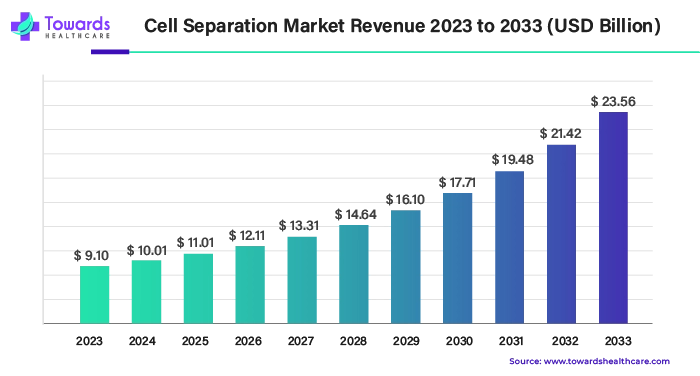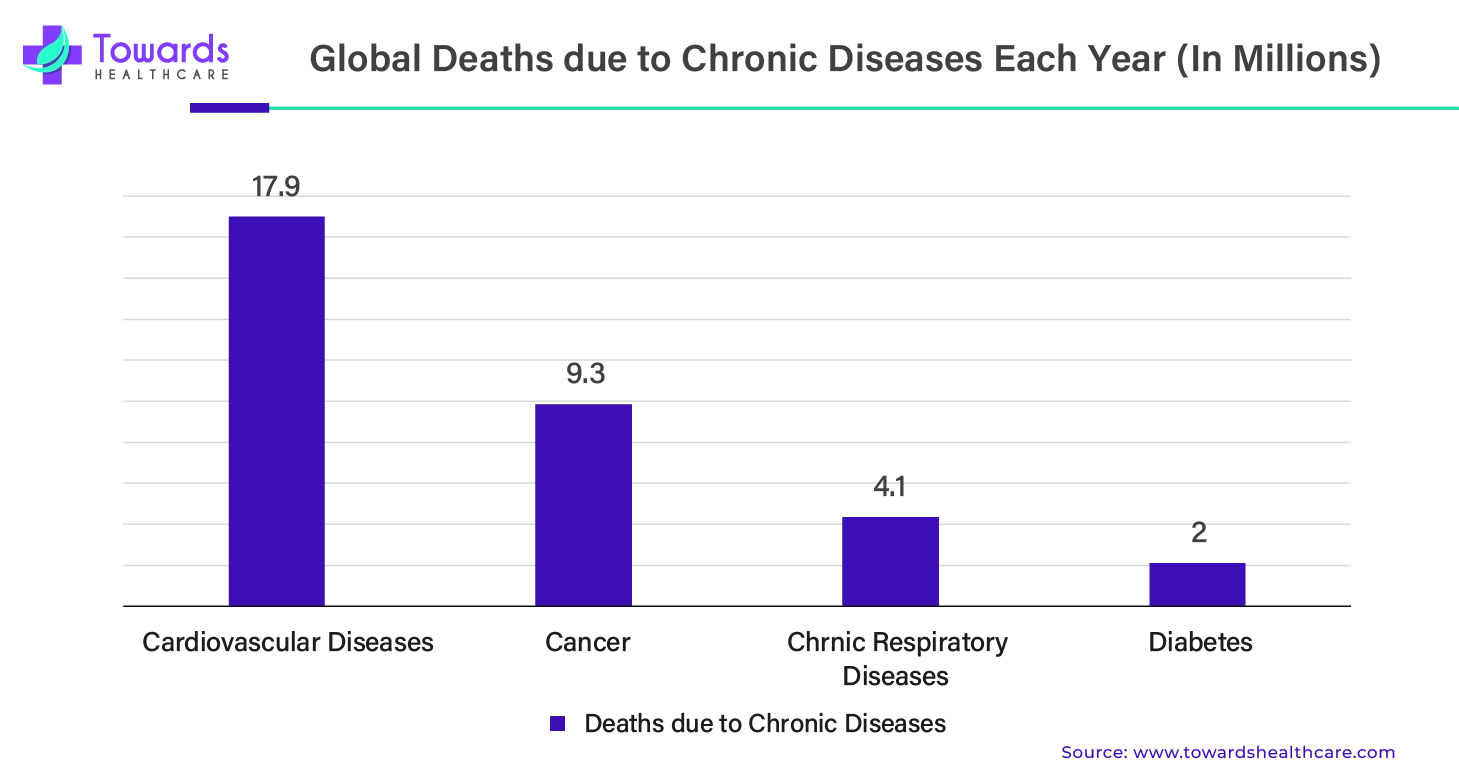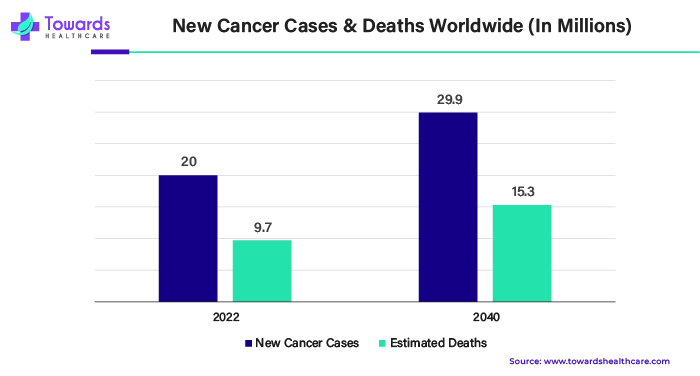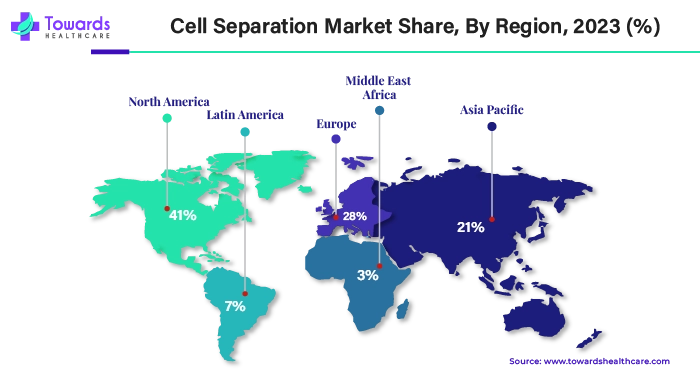April 2025

The global cell separation market size was estimated at US$ 9.10 billion in 2023 and is projected to grow US$ 23.56 billion by 2033, rising at a compound annual growth rate (CAGR) of 9.98% from 2024 to 2033. The rising prevalence of infectious and chronic diseases drives the market’s growth.

The cell separation market is growing significantly due to the application of cell separation in various fields, including therapeutic protein production, biologics, diagnostics, oncology research, and so on. Cell separation is the process of separating one or more particular cell populations from a heterogeneous mixture of cells. It is also sometimes referred to as cell isolation or sorting. By reducing the influence of other cell types in the sample, conducting tests on isolated cells enables scientists to securely respond to certain research topics. There are several uses for isolated cells in life science research. One of the main drivers of the need for customized medications and the development of efficient generalized techniques for treating big populations is cell separation.
| Company Name | Akadeum Life Sciences |
| Headquarters | Michigan, U.S. |
| Recent Launch | In May 2024, in Baltimore, Maryland, for the 27th Annual Meeting of the American Society of Gene & Cell Therapy, Akadeum Life Sciences, the leading company in buoyancy-based cell separation, is launching several cutting-edge new technologies. With a wide selection of GMP-grade solutions as a consequence of their unmatched product development speed, Akadeum has demonstrated its dedication to revolutionizing clinical cell therapy research and development for millions of patients globally. |
| Company Name | LevitasBio |
| Headquarters | California, U.S. |
| Recent Launch | In November 2023, in order to create and produce its revolutionary new LeviCell® EOS system for cell separation and enrichment during sample preparation, LevitasBio® has teamed up with Planet Innovation. Several units of the LeviCell EOS have already been placed at prestigious research facilities around the United States since its mid-year introduction, which saw robust early sales. Researchers may get higher-quality samples for further study with the LeviCell EOS system because it employs the same ground-breaking Levitation Technology as its predecessor, LeviCell 1.0, to enhance cell populations without changing, straining, or harming cells. |

Some of the leading causes of morbidity and death globally have been and still are chronic illnesses, including diabetes, heart disease, stroke and cancer. By 2030, chronic illness is predicted to cost the global economy $47 trillion. Chronic illness is a huge financial burden on the American healthcare system, costing the country about $1 trillion annually. Noncommunicable diseases (NCDs) account for 41 million annual deaths worldwide, or 74% of all fatalities, according to the WHO. 17 million individuals die from NCDs before they become 70 years old every year; low- and middle-income nations account for 86% of these premature fatalities.
Cell separation is useful in chronic conditions for isolating specific cell populations for analysis and treatment. By separating diseased cells from healthy cells, researchers can study the specific characteristics of the diseased cells and develop targeted treatments. This process also allows for the isolation of rare cells for further study, potentially leading to a better understanding of the disease mechanisms and more effective therapeutic interventions.
Cell biology is studied in-depth to develop cutting-edge therapeutics like gene and stem cell therapies. To obtain accurate findings, the best reagents, instruments, and other supplies must be utilized in this study. The reason that cell biology research is expensive is that it has to maintain strict guidelines and follow rules issued by regulatory agencies. Furthermore, the majority of cell treatment trials have a low success rate and virtually little research involving cells has proven fruitful. Many organizations and small enterprises are unable to afford to buy pricey items because of budgetary constraints. One of the primary factors impeding the growth of the cell separation instrument market is this.
A valuable technique employed in many areas of biological and biomedical research, as well as therapeutic medicine, is cell separation. The quality of repair and the ensuing clinical result of cell-based therapeutic therapies may be enhanced by the application of highly selective cell separation techniques. A growing number of researchers are employing or wishing to utilize cell separation methods as a consequence of this potential, which has led to an increase in the use of these approaches in the disciplines of tissue engineering and regenerative medicine.
For instance,

The consumables segment dominated the cell separation market by 63% in 2023. Consumables include kits and reagents, media, beads and disposables, which are used for cell growth and further preparation for isolation. As little as eight minutes might be required to extract highly pure cells using some of the quickest cell isolation kits. A number of commercial instruments, kits, and reagents are available for density gradient centrifugation separation. Cell growth media, cell labeling chemicals, and cell separation solutions are all included in the kits and reagents. Cell isolation, which is also known as cell separation or sorting, is a technique that uses magnetic beads to target cells for depletion or selection using ligands or antibodies that are specific to certain cell surface antigens. Methods for magnetic bead cell separation allow for both positive and negative cell selection in addition to cell depletion.
For instance,
By cell type, the animal cells segment held the dominant share of the cell separation market by 55% in 2023. The process of isolating cells and cultivating them in artificial environments is usually used in animal cell culture. Animal cell culture is an essential approach in the development of viral vaccines. Hematopoietic growth factors, growth factors, hormones, blood products, and enzymes are among the recombinant therapeutic proteins that may be produced in animal cell cultures. Innovations in gene therapy depend on the advancement of animal cell culture. Large-scale manufacturing of proteins and antibodies—which would otherwise need a significant financial outlay—can be achieved through the use of animal cells.
By cell type, the human cells segment is anticipated to show the fastest growth during the predicted period. In order to do biomedical research, human cell culture is now required. Even though cell culture has been shown to have an impact on gene expression, human cell culture techniques are necessary to examine the impact of human genetic diversity on gene expression. The ability of human cell-based research to provide mechanistic and therapeutic insights has been greatly enhanced by technological advancements. Human cell culture finds its greatest value in the stem cell business, where mesenchymal stem cells may be grown and cryopreserved for later use. For hundreds of thousands of patients each year, tissue engineering may provide significantly better, more affordable healthcare.
For instance,
By technique, the centrifugation segment held the largest cell separation market share in 2023. With the use of gradient media, density gradient centrifugation divides cell populations according to their relative densities. Differential centrifugation is an additional method of centrifugation that divides particles according to size. Bypassing the sample through the centrifuge several times without a density gradient enables particles with the same density to be distinguished by distinct characteristics. Depending on the centrifuge's size, centrifugation may be helpful for separating materials on a big scale. Consistency in efforts might lead to a higher total yield.
For instance,
By technique, the surface marker technique is estimated to grow at the fastest CAGR during 2024-2033. With FACS, the most highly pure cellular preparations are produced by utilizing a fluorescently tagged antibody as the cell-surface marker. A range of surface markers can be combined to distinguish between distinct cell subsets. Cell markers have the ability to facilitate the cell's key functions beyond simple categorization. In addition to being employed as therapy targets, these cell markers can aid in diagnosis. Cell types may be distinguished, and scientists can target certain cell subsets by using cell surface markers that are only expressed in that group of cells.
For instance,
The biomolecule isolation segment dominated the cell separation market in 2023 by application. Biomolecules are molecules produced by living organisms. They can be nucleic acids, carbohydrates, metabolites, proteins, hormones, and lipids. Different living organisms and cells produce different types of biomolecules. Cell separation techniques make the production and isolation of biomolecules easy and efficient. Through the use of cell separation methods, it is possible to isolate certain cells that may then be cultivated to create biomolecules on a large scale. Biomolecules may be generated and synthesized on a large scale utilizing sophisticated procedures, and they can be modified to make them appropriate for the suggested uses. Biomolecules are used in a wide range of sectors, including wastewater treatment, biofuels, textiles, pharmaceuticals, cosmetics and pulp and paper.
By application, the cancer research segment is estimated to grow significantly during the projected period. For many years, it has been evident how important early cancer detection and better cancer treatment are. This has led to an international investigation into new avenues for the use of technical advancements in cancer patient care. Since circulating tumor cells (CTC) may have a significant role in early cancer diagnosis and prognosis, one of the main areas of research is the isolation and detection of CTC.
Additionally, the market for cell separation is expanding due to the frequency of cancer. A major cause of death throughout the globe is cancer. As people age, their chance of developing certain cancers increases, which is most certainly the cause of the sharp increase in cancer incidence. The following are risk factors for non-communicable illnesses like cancer: air pollution, alcoholism, bad food, physical inactivity and tobacco use.

North America dominated the cell separation market in 2023. Many things contribute to its importance, one of which is the existence of well-established biotechnology and pharmaceutical businesses, especially in the United States. The region's market position is further strengthened by the high pace at which technologically innovative solutions are adopted. Moreover, there is a considerable need for cell separation solutions due to the broad research projects undertaken by research universities in North America, especially in the area of cell treatments.
In the U.S., the prevalence of chronic disorders and other health issues increased the demand for research and development and personalized medicines that use cell separation for the study of biomolecules and the development of vaccines, antibodies, and cell therapies. These factors contribute to the growth of the cell separation market in the U.S.
For instance,
According to the U.S. Department of Health and Human Services, an estimated 129 million Americans suffer from at least one severe chronic illness (1), such as diabetes, cancer, heart disease, obesity, or hypertension. Four in ten Americans suffer from two or more chronic diseases, and twelve percent have five or more. Treatment and management of chronic illnesses and mental health issues account for around 90% of the $4.1 trillion in healthcare spending that occurs each year.
Asia Pacific is anticipated to grow at the fastest rate during the forecast period. The pharmaceutical and biotechnology sectors in developing nations like China and India are seeing significant growth, which is the reason for this expansion. Increased healthcare spending and the growing market penetration of large international companies in important Asia-Pacific nations are other factors driving the growth of the cell separation market. The need for cell separation solutions in the area has also been boosted by continuing stem cell and gene therapy research projects in nations like South Korea, China and Japan.
China's venture capital investment market for breakthrough medicine has seen a significant change in recent years. China is a leader in the field of cell treatment, especially when it comes to CAR-T therapy or chimeric antigen receptor T-cell therapy. The extraordinary rise of cell therapy in China has also been greatly aided by the nation's NMPA. To show how committed the government is to these goods, the NMPA produced eight rules in 2022 alone to hasten the clinical development of cell therapy drugs.
For instance,
By Product
By Cell Type
By Technique
By Application
By Region
April 2025
April 2025
April 2025
April 2025